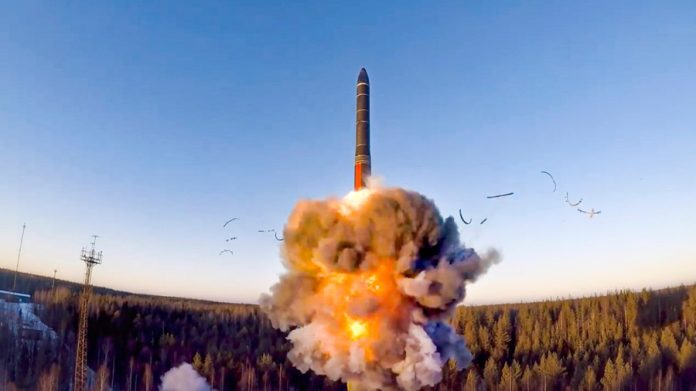
In a recent op-ed for The Hill, “America Isn’t Prepared for a Strike Against our Nuclear Weapons,” freelance journalist Ben Ollerenshaw argued that the U.S. is woefully unprepared for the nuclear threats facing the nation because it relies on a “single point of failure: the nuclear command, control and communications systems.”
He explains that the nation is dependent on highly vulnerable E-6B Mercury command-and-control aircraft that, because they are now on “ground alert” rather than flying 24/7, make easy targets for a surprise nuclear, drone or missile attack.
Should such an attack occur, Ollerenshaw argues that the president could no longer employ the nation’s nuclear weapons. Fortunately, this is simply untrue. The nuclear command, control and communications system has far more ways to transmit presidential orders.
The system connects sensors and shooters with decision-makers using a detect, decide, and direct framework. Detection harnesses sensors that identify and correlate adversary launches to facilitate warning. Once detection is established and the assessment is made, senior leaders confer, review plans and determine appropriate courses of action during the decision process.
Finally, presidential decisions are transmitted through the system to the nuclear forces charged with weapons employment, under any circumstance or environment, guaranteed. To accomplish this audacious mission, the system must be survivable, prompt and flexible.
Keep in mind that the nation’s nuclear command, control and communications system is essentially a system of systems resembling a spider web. If one strand is broken, there are other strands a president can use to ensure a message is transmitted to forces in the field. Historically, it was thought of as having a “thick line” during times of peace, and a survivable “thin line” during times of war, should a Soviet nuclear attack devastate the U.S.
In peacetime, the National Military Command Center at the Pentagon and the Global Operations Center at US Strategic Command serve as the primary command and control centers for the nation’s nuclear forces. These facilities are not designed to survive direct nuclear strikes, but for the last seven decades, they and their predecessors performed the job in times of peace and crisis.
During the Cold War (1961-1990), the country also maintained EC-135 command-and-control aircraft in continuous airborne operations, flying around the clock, seven days a week. The airborne command post mirrored the capabilities of the Global Operations Center, so that if the latter was destroyed in a nuclear attack, the Airborne Emergency Action Officer could take over and perform the duties of commander for the Strategic Air Command.
The Looking Glass aircraft were an insurance policy against a surprise Soviet nuclear strike. They enhanced second-strike capability, strengthened strategic stability, and provided a psychological and political signal. The continuous presence of Looking Glass sent a clear signal of American resolve, vigilance and readiness to respond, reinforcing the overall framework of strategic deterrence.
This did not, however, mean that the National Military Command Center, Global Operations Center and Looking Glass aircraft were the only ways for the president to command and control nuclear forces. It was, in fact, expected that both the National Military Command Center and Global Operations Center would be destroyed early in a Soviet nuclear strike, and that the command post aircraft would quickly take over.
There was, however, always a concern that the aircraft would either be destroyed by Soviet aircraft or missiles or simply run out of fuel for lack of remaining and available aerial refueling capability. So it should come as no surprise that the Air Force devised “backups to our backups” and spent considerable time working through all plausible scenarios where not only were the National Military Command Center and the Global Operations Center destroyed in an attack, but so were the KC-135s and now E-6B fleet.
In our own careers, we have participated in wargames, exercises and working groups where just such events occurred. It is also important to understand that U.S. Strategic Command, the joint staff, and other elements of the national command authority regularly conduct exercises under conditions that mimic catastrophic events. This means the uniformed and civilian personnel who operate the nuclear command, control and communications system regularly train to operate in degraded conditions.
The 2022 Nuclear Posture Review, released under the Biden administration, reiterated a longstanding policy that “while the United States maintains the capability to launch nuclear forces under conditions of an ongoing nuclear attack, it does not rely on a launch-under-attack policy to ensure a credible response. Rather, U.S. nuclear forces are postured to withstand an initial attack.”
For decades, the U.S. opted for redundancy to meet its resilience requirement. Redundant systems, redundant command nodes, and redundant communication pathways require consistent resourcing and persistent exercise if America is to retain its noble intent to “ride out” a first strike.
There is no deterrence without a credible threat of existential retaliation. That means America’s nuclear command, control and communications systems must always work after a first strike on the homeland. From nuclear arsenal resourcing to force posture and launch policy, America’s deterrent cannot depend on hope to survive; it must depend on action. That is exactly how the system is designed.
Adam Lowther, Ph.D., is the vice president of research at the National Institute for Deterrence Studies. He spent two decades as a civil servant in the Department of Defense nuclear enterprise. Col. (Ret.) Curtis McGiffin is the vice president of education at the National Institute for Deterrence Studies. He flew nuclear command-and-control aircraft during his career.

